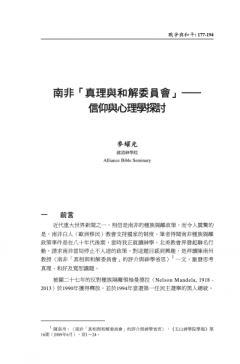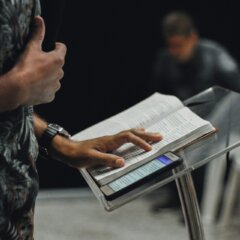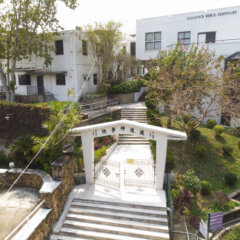南非「真理與和解委員會」——信仰與心理學探討/麥耀光
麥耀光
撮要
二十世紀八十年代,南非採取種族隔離政策,而南非白人教會卻支持國家的制度。被關二十七年的反對種族隔離領袖曼德拉於1990年釋放,並於1994年當選第一任民主選舉的黑人總統。面對政權轉移,曼德拉做了一個舉世矚目的行動,他成立「真相與和解委員會」,並由當時大主教屠圖任主席,目的乃是和解。
屠圖主教的職責,一方面是在政權轉移時,如何妥善處理過往歷史的問題,另一方面,為了帶出和解,他選擇了第三條路線,就是避免紐倫堡大審和無條件大赦這兩個極端方案的另一選擇,這引來多方面的批評。
本文嘗試從基督教信仰和心理輔導學角度來看「真相與和解委員會」要處理真相、公義、和解及寬恕等議題。文章首先交代一點點南非種族隔離的背景後,便介紹「真相與和解委員會」的成立和其任務。第二部分就按幾個議題作出反思。
ABSTRACT
In the eighties of the twentieth century, the South Africa adopted an apartheid policy which the white church had supported it. After being prisoned for 27 years, the leader of the anti-campaign, Nelson Mandela (1918 – 2013), was released in 1990. Mandela was the first elected president of the democratic election. During the transition of political power, Mandela set up The Truth and Reconciliation Commission for the purpose of healing national trauma.
Arch Bishop Tutu was appointed to direct the Commission. He had dual duties. On the one hand, Tutu needed to settle the historical problems; on the other hand, he had a task to bring reconciliation in the nation. He faced three options. However, he refused to follow the footstep of Nuremberg Trial or unconditional amnesty. He had chosen a third alternative.
This paper tries to look at the Truth and Reconciliation Commission from the faith and psychological perspectives. We need to examine key issues such as truth, justice, reconcile and forgiveness. The first part of the paper outlines briefly the South Africa’s apartheid policy. After surveys the aims and tasks of the Commission, we will look at several issues with comment.
原載於《建道學刊》46期(2016年7月),頁 177-194。
作者簡介
麥耀光
實用神學部主任
最新文章
[電子書]困境與抉擇:「建道研究中心30週年誌慶」跨學科研討會論文集/廖炳堂、倪步曉主編
2025 年 1 月 2 日
一篇特稿:好好事奉主! / 梁國強
2025 年 1 月 1 日
「牧範」與「硬淨」! / 梁國強
2024 年 11 月 1 日
编辑精选
從梧州到長洲:建道神學院125年的挑戰與恩典 / 陳智衡
2023 年 10 月 1 日
微小教會的見證/高銘謙
2023 年 6 月 1 日







